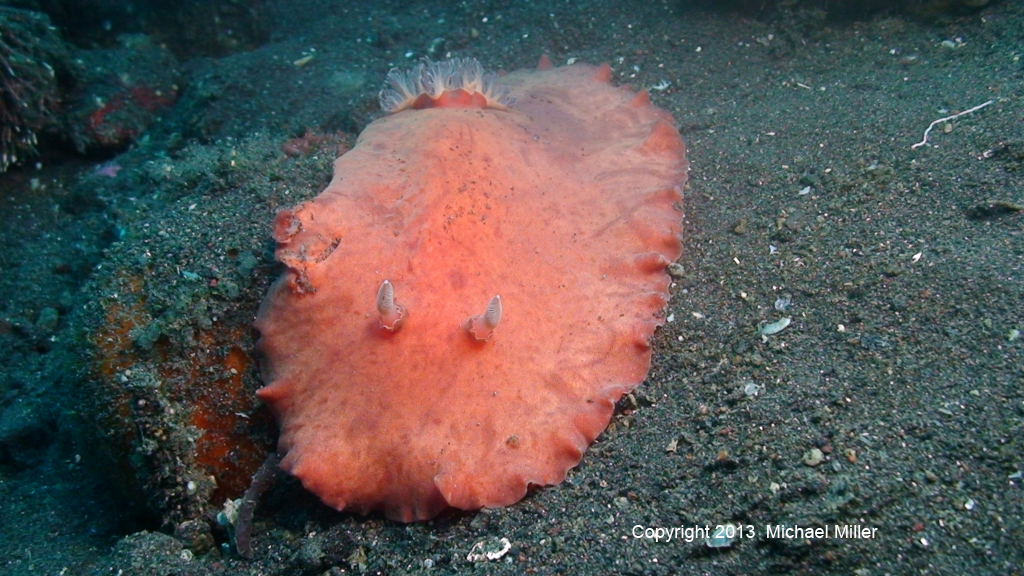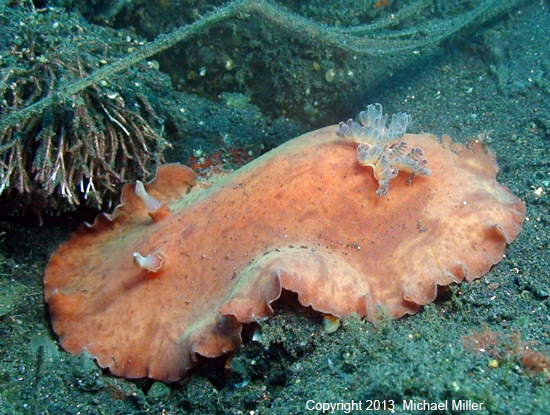 |
Platydoris cinerobranchiata
Image courtesy of Michael MillerSeraya Secrets, Bali, Indonesia
Est. size 120mm
Still Frame from Sony HC-3 Camcorder and two (2) Sola 1200 video lights
Platydoris cinerobranchiata
 |
Platydoris cinerobranchiata Dorgan, Valdes and Gosliner (2002) I hate to admit it, but members of this genus drive me crazy. A recent paper by Dorgan, Valdes and Gosliner (2002), where this species was originally described, helps greatly in identifying these guys however. All of the 17 species in the genus, Platydoris, are variable in coloration, but P. cinerobranchiata, may exhibit the greatest variation. The color seen in our previous P. cinerobranchiata is more typical, tan with a smattering of red blotches. Mike's photo here shows an extreme closest to P. formosa (Courtesy of Bill Rudman's Seaslug Forum) the gill color separates the two. The name Platydoris tell us that these guys are flat bodied, but gives no hint that they are some of the largest dorids we will come across. Most importantly from a systematic standpoint is that the members of this subgroup of the family Discodorididea, have the dorsum covered with caryophyllidia, and organ bearing spicules surrounding a central knob covered with cilia. You can see a scanning electron micrograph of these organs on page 183 of Indo-Pacific Nudibranchs. Although extremely obvious visually and texturally, the function of this organ is still unknown. What is known is that all species bearing caryophyllidia are derived from a single common ancestor. Reference: K.M. Dorgan, A. Valdes & T.M. Gosliner. 2002. Phylogenetic systematics of the genus Platydoris (Mollusca, Nudibranchia, Doridoidea) with descriptions of six new species. Zoologica Scripta. 31(3): 271-319. |
Sammamish, WA 98074
Feb., 2013
Send Dave email at davidwbehrens@gmail.com
WEBMASTER'S NOTES Yes, I know what you readers are thinking! And you are right! The two images above are of the same slug! So why the difference in color variation? It's all in the lightning! When our guide first pointed out P. cinerobranchiata with no lightning other than ambient, it appeared to have a uniform tan appearance which puzzled me to no end. When I put the video lights on it, the red coloration popped out with an intensity dependent on how much light was put on it! The light output from the Sola's was sufficent to enable a still photo from a Camcorder based on 2006 technology! The Camcorder system really needs to be stablized to make this possible but its worth the effort. Without the LED lights, I never would have been able to capture the above photos.
San Diego, Calif
Feb., 2013

|
